Meta-Analysis of Yields of Crops Fertilized with Compost Tea and Anaerobic Digestate
Abstract
:1. Introduction
2. Methodology
2.1. Systematic Bibliographic Search
2.2. Selection Criteria
- Papers based on scientific experiments including at least one treatment of pure fertilization with anaerobic digestate or compost tea (not combined with any other organic or synthetic fertilizer);
- Papers based on experiments including a control treatment (no fertilizer), and optionally a pure synthetic fertilizer treatment (not combined with organic fertilizers).
- Papers based on field, greenhouse, and pot experiments were selected (papers based on in vitro experiments were discarded);
- Papers based on experiments lasting at least 3 weeks or longer;
- Papers informing average crop yield value for each treatment, along with individual or pooled dispersion measures;
- Papers that measured crop yield as biomass: dry or fresh weight of either the total plant, aerial part or the organ of agronomic interest (e.g.,: fruit). When both dry and fresh weights were reported, the former was selected. Other measures, such as leaf area or number of fruits, were discarded.
2.3. Meta-Analysis
- Dataset 1: RR of average yield obtained by fertilization with digestate or compost tea, in relation with the average yield of the corresponding control treatment (same experimental conditions except fertilization);
- Dataset 2: RR of average yield obtained by fertilization with digestate or compost tea, in relation with the average yield produced by application of conventional fertilizer (same experimental conditions except fertilization).
2.3.1. Data Extraction
2.3.2. Basic Formulae
- o
- Equation (2): observation of L
- Equation (3): Variance of L:
2.3.3. Preliminary Analyses
2.3.4. Software
3. Theory/Calculation
3.1. Meta-Analytic Model
3.2. Estimation of Between-Study Variance
- Cochran’s Q: it is a standardized measure calculated as the sum of the squares of the difference between each observed effect size (ESj) and the fixed-effect model estimate of the overall effect size (M), weighted by the inverse of each study’s variance (SDj2). This value was used in the influence analyses to determine which observations had greater contribution to overall heterogeneity. Its formula, according to Borenstein (2009) [18], can be written as Equation (6).
- Higgin’s and Thompson’s I2: represents the percentage of variability in the effect sizes which is not caused by sampling error [29]. It is derived from Q, with the following formula (Equation (7)):
3.3. Subgroup Analyses
3.4. Publication Bias
4. Results
4.1. Analysis 1: Organic Fertilizer/Control Response Ratio
4.1.1. Dataset 1 Observations
4.1.2. Meta-Analysis of RR
4.1.3. Subgroup Analyses of Digestate/Control Yield RR
4.2. Analysis 2: Organic Fertilizer/Synthetic Fertilizer Response Ratio
4.2.1. Dataset 2 Observations
4.2.2. Meta-Analysis of RR
4.2.3. Subgroup Analyses of Digestate/Control Yield RR
4.3. Publication Bias Analyses
4.3.1. Egger’s Test
4.3.2. Trim and Fill
5. Discussion
6. Conclusions
Author Contributions
Funding
Institutional Review Board Statement
Informed Consent Statement
Data Availability Statement
Conflicts of Interest
References
- Luo, G.; Li, L.; Friman, V.-P.; Guo, J.; Guo, S.; Shen, Q.; Ling, N. Organic amendments increase crop yields by improving microbe-mediated soil functioning of agroecosystems: A meta-analysis. Soil Biol. Biochem. 2018, 124, 105–115. [Google Scholar] [CrossRef]
- Wang, L.; Li, Q.; Coulter, J.A.; Xie, J.; Luo, Z.; Zhang, R.; Deng, X.; Li, L. Winter wheat yield and water use efficiency response to organic fertilization in northern China: A meta-analysis. Agric. Water Manag. 2020, 229, 105934. [Google Scholar] [CrossRef]
- Mamani, A.I.d.F.; Filippone, M.P. Bioinsumos: Componentes claves de una agricultura sostenible. Rev. Agron. Noroeste Argent. 2018, 38, 9–21. [Google Scholar]
- De Corato, U. Agricultural waste recycling in horticultural intensive farming systems by on-farm composting and compost-based tea application improves soil quality and plant health: A review under the perspective of a circular economy. Sci. Total Environ. 2020, 738, 139840. [Google Scholar] [CrossRef]
- Alzamel, N.M.; Taha, E.M.M.; Bakr, A.A.A.; Loutfy, N. Effect of Organic and Inorganic Fertilizers on Soil Properties, Growth Yield, and Physiochemical Properties of Sunflower Seeds and Oils. Sustainability 2022, 14, 12928. [Google Scholar] [CrossRef]
- Biancini, G.; Marchetti, B.; Cioccolanti, L.; Moglie, M. Comprehensive Life Cycle Assessment Analysis of an Italian Composting Facility concerning Environmental Footprint Minimization and Renewable Energy Integration. Sustainability 2022, 14, 14961. [Google Scholar] [CrossRef]
- Islam, S.F.-U.; de Neergaard, A.; Sander, B.O.; Jensen, L.S.; Wassmann, R.; van Groenigen, J.W. Reducing greenhouse gas emissions and grain arsenic and lead levels without compromising yield in organically produced rice. Agric. Ecosyst. Environ. 2020, 295, 106922. [Google Scholar] [CrossRef]
- Muhmood, A.; Javid, S.; Ahmad, Z.; Majeed, A.; Rafique, R. Integrated use of bioslurry and chemical fertilizers for vegetable production. Pak. J. Agric. Sci. 2014, 51, 565–570. [Google Scholar]
- Pane, C.; Palese, A.M.; Spaccini, R.; Piccolo, A.; Celano, G.; Zaccardelli, M. Enhancing sustainability of a processing tomato cultivation system by using bioactive compost teas. Sci. Hortic. 2016, 202, 117–124. [Google Scholar] [CrossRef]
- Evans, K.J.; Percy, A.K. Integrating Compost Teas in the Management of Fruit and Foliar Diseases for Sustainable Crop Yield and Quality; Composting for Sustainable Agriculture; Springer International Publishing: Cham, Switzerland, 2014; Volume 3, pp. 173–198. [Google Scholar] [CrossRef]
- Dukare, A.S.; Prasanna, R.; Dubey, S.C.; Nain, L.; Chaudhary, V.; Singh, R.; Saxena, A.K. Evaluating novel microbe amended composts as biocontrol agents in tomato. Crop Prot. 2011, 30, 436–442. [Google Scholar] [CrossRef]
- Siddiqui, Y.; Islam, T.M.; Naidu, Y.; Meon, S. The conjunctive use of compost tea and inorganic fertiliser on the growth, yield and terpenoid content of Centella asiatica (L.) urban. Sci. Hortic. 2011, 130, 289–295. [Google Scholar] [CrossRef]
- Iocoli, G.A.; Gómez, M.A. Utilización de digerido anaeróbico de purín de cerdo: Actividad biológica del suelo y desarrollo vegetal. Cienc. Suelo 2015, 33, 1–9. [Google Scholar]
- De Groot, L.; Bogdanski, A. Bioslurry = Brown Gold? A Review of Scientific Literature on the Co-Product of Biogas Production; Environment and Natural Resources Management, FAO: Rome, Italy, 2013; p. 33. [Google Scholar]
- Pampillón-González, L.; Luna-Guido, M.; Ruíz-Valdiviezo, V.M.; Franco-Hernández, O.; Fernández-Luqueño, F.; Paredes-López, O.; Hernández, G.; Dendooven, L. Greenhouse Gas Emissions and Growth of Wheat Cultivated in Soil Amended with Digestate from Biogas Production. Pedosphere 2017, 27, 318–327. [Google Scholar] [CrossRef]
- Kim, M.J.; Shim, C.K.; Kim, Y.K.; Hong, S.J.; Park, J.H.; Han, E.J.; Kim, J.H.; Kim, S.C. Effect of Aerated Compost Tea on the Growth Promotion of Lettuce, Soybean, and Sweet Corn in Organic Cultivation. Plant Pathol. J. 2015, 31, 259–268. [Google Scholar] [CrossRef] [Green Version]
- Martin, C.C.G.S. Potential of compost tea for suppressing plant diseases. CAB Rev. Perspect. Agric. Veter Sci. Nutr. Nat. Resour. 2014, 2014, 1–38. [Google Scholar] [CrossRef] [Green Version]
- Borenstein, M. Introduction to Meta-Analysis; John Wiley & Sons: New York, NY, USA, 2021; p. 544. [Google Scholar]
- Warnars, L.; Oppenoorth, H.; Bioslurry: A supreme fertilizer. A study on bioslurry results and uses. In Proceedings of the IFOAM Organic World Congress 2014, ‘Building Organic Bridges’, Istanbul, Turkey, 13–15 October 2014; Hivos People Unlimited: Díli, Timor-Leste, 2014. [Google Scholar]
- Möller, K.; Müller, T. Effects of anaerobic digestion on digestate nutrient availability and crop growth: A review. Eng. Life Sci. 2012, 12, 242–257. [Google Scholar] [CrossRef]
- Bonten, L.T.C.; Zwart, K.B.; Rietra, R.P.J.J.; Postma, R.; de Haas, M.J.G. Bio-Slurry as Fertilizer—Is Bio-Slurry from Household di-Gesters a Better Fertilizer than Manure? A Literature Review; Alterra Wageningen UR: Wageningen, The Netherlands, 2014; p. 45. [Google Scholar]
- Marín, F.; Diánez, F.; Gea, F.J.; Navarro, M.J.; Santos, M. Effect of compost tea on plant growth and plant disease management. In Sustainable Crop Disease Management Using Natural Products; CABI: Wallingford, UK, 2015; pp. 234–2654. [Google Scholar] [CrossRef]
- Nakagawa, S.; Noble, D.W.A.; Senior, A.M.; Lagisz, M. Meta-evaluation of meta-analysis: Ten appraisal questions for biologists. BMC Biol. 2017, 15, 18. [Google Scholar] [CrossRef] [Green Version]
- Jin, Z.-C.; Zhou, X.-H.; He, J. Statistical methods for dealing with publication bias in meta-analysis. Stat. Med. 2014, 34, 343–360. [Google Scholar] [CrossRef]
- Hedges, L.V.; Gurevitch, J.; Curtis, P.S. The Meta-Analisys of Response Ratios in Experimental Ecology. Ecology 1999, 80, 1150–1156. [Google Scholar] [CrossRef]
- Ding, W.; Xu, X.; He, P.; Ullah, S.; Zhang, J.; Cui, Z.; Zhou, W. Improving yield and nitrogen use efficiency through alternative fertilization options for rice in China: A meta-analysis. Field Crop. Res. 2018, 227, 11–18. [Google Scholar] [CrossRef]
- Liu, B.; Wang, X.; Ma, L.; Chadwick, D.; Chen, X. Combined applications of organic and synthetic nitrogen fertilizers for improving crop yield and reducing reactive nitrogen losses from China’s vegetable systems: A meta-analysis. Environ. Pollut. 2020, 269, 116143. [Google Scholar] [CrossRef]
- Cochrane Collaboration. Cochrane Handbook for Systematic Reviews of Interventions; Cochrane Collaboration: London, UK, 2008. [Google Scholar]
- Harrer, M.; Cuijpers, P.; Furukawa, T.A.; Ebert, D.D. Doing Meta-Analysis with R: A Hands-On Guide; Chapman and Hall/CRC: London, UK, 2019; Available online: https://bookdown.org/MathiasHarrer/Doing_Meta_Analysis_in_R/ (accessed on 19 December 2022).
- Viechtbauer, W. Conducting Meta-Analyses in R with themetaforPackage. J. Stat. Softw. 2010, 36, 1–48. [Google Scholar] [CrossRef] [Green Version]
- Rohatgi, A. WebPlotDigitizer, Version 4.4. 2020. Available online: https://automeris.io/WebPlotDigitizer/ (accessed on 23 April 2021).
- Olkin, I.; Dahabreh, I.J.; Trikalinos, T.A. GOSH—A graphical display of study heterogeneity. Res. Synth. Methods 2012, 3, 214–223. [Google Scholar] [CrossRef]
- R Core Team. R: A Language and Environment for Statistical Computing, Version 4.0.3; R Foundation for Statistical Computing: Vienna, Austria, 2020; Available online: https://www.R-project.org/ (accessed on 19 December 2022).
- Schwarzer, G. Meta: General Package for Meta-Analysis, Version 4.15-1. 2021. Available online: https://CRAN.R-project.org/package=meta (accessed on 4 May 2021).
- Viechtbauer, W. Metafor: Meta-Analysis Package for R, Version 3.0-2. 2021. Available online: https://CRAN.R-project.org/package=metafor (accessed on 4 May 2021).
- Harrer, M.; Cuijpers, P.; Ebert, D. Dmetar: Doing Meta-Analysis in R. Zenodo 2019. [Google Scholar] [CrossRef]
- Wickham, H.; François, R.; Henry, L.; Müller, K. Dplyr: A Grammar of Data Manipulation; R Package Version 0.8.4. 2020. Available online: https://CRAN.R-project.org/package=dplyr (accessed on 4 May 2021).
- Wickham, H.; Bryan, J.; RStudio; Kalicinski, M.; Komarov, V.; Leitienne, C.; Colbert, B.; Hoerl, D.; Miller, E. Readxl: Read Excel Files, Version 1.3.1. 2019. Available online: https://CRAN.R-project.org/package=readxl (accessed on 19 December 2022).
- Wickham, H.; Chang, W.; Henry, L.; Pedersen, T.L.; Takahashi, K.; Wilke, C.; Woo, K.; Yutani, H.; Dunnington, D.; RStudio. ggplot2: Create Elegant Data Visualisations Using the Grammar of Graphics, Version 3.3.5. 2021. Available online: https://CRAN.R-project.org/package=ggplot2 (accessed on 4 May 2021).
- Allaire, J.J.; Xie, Y.; McPherson, J.; Luraschi, J.; Ushey, K.; Atkins, A.; Wickham, H.; Cheng, J.; Chang, W.; Iannone, R.; et al. Rmarkdown: Dynamic Documents for R, Version 2.9. 2021. Available online: https://CRAN.R-project.org/package=rmarkdown (accessed on 10 May 2021).
- Xie, Y.; Allaire, J.J.; Kim, A.; Samuel-Rosa, A.; Oles, A.; Yasumoto, A.; Frederik, A.; Quast, B.; Marwick, B.; Ismay, C.; et al. Bookdown: Authoring Books and Technical Documents with R Markdown, Version 0.22. 2021. Available online: https://CRAN.R-project.org/package=bookdown (accessed on 10 May 2021).
- Zhu, H.; Travison, T.; Tsai, T.; Beasley, W.; Xie, Y.; Yu, G.; Laurent, S.; Shepherd, R.; Sidi, Y.; Salzer, B.; et al. KableExtra: Construct Complex Table with «kable» and Pipe Syntax, Version 1.3.4. 2021. Available online: https://CRAN.R-project.org/package=kableExtra (accessed on 4 May 2021).
- Xie, Y.; Sarma, A.; Vogt, A.; Andrew, A.; Zvoleff, A.; Andre-Simon, A.S.; Atkins, A.; Wolen, A.; Manton, A.; Yasumoto, A.; et al. Knitr: A General-Purpose Package for Dynamic Report Generation in R, Version 1.33. 2021. Available online: https://CRAN.R-project.org/package=knitr (accessed on 4 May 2021).
- Veroniki, A.A.; Jackson, D.; Viechtbauer, W.; Bender, R.; Bowden, J.; Knapp, G.; Kuss, O.; Higgins, J.P.; Langan, D.; Salanti, G. Methods to estimate the between-study variance and its uncertainty in meta-analysis. Res. Synth. Methods 2015, 7, 55–79. [Google Scholar] [CrossRef] [PubMed] [Green Version]
- Bakbergenuly, I.; Hoaglin, D.C.; Kulinskaya, E. Estimation in meta-analyses of response ratios. BMC Med. Res. Methodol. 2020, 20, 263. [Google Scholar] [CrossRef] [PubMed]
- Egger, M.; Smith, G.D.; Schneider, M.; Minder, C. Bias in meta-analysis detected by a simple, graphical test. BMJ 1997, 315, 629–634. [Google Scholar] [CrossRef] [Green Version]
- Duval, S.; Tweedie, R. Trim and Fil l: A Simple Funnel-Plot-Based Method of Testing and Adjusting for Publication Bias in Meta-Analysis. Biometrics 2000, 56, 455–463. [Google Scholar] [CrossRef]
- Reeve, J.R.; Carpenter-Boggs, L.; Reganold, J.P.; York, A.L.; Brinton, W. Influence of biodynamic preparations on compost development and resultant compost extracts on wheat seedling growth. Bioresour. Technol. 2010, 101, 5658–5666. [Google Scholar] [CrossRef]
- Ren, H.; Hu, J.; Hu, Y.; Yang, G.; Zhang, Y. Divergence of compost extract and bio-organic manure effects on lucerne plant and soil. PeerJ 2017, 5, e3775. [Google Scholar] [CrossRef] [Green Version]
- Ciaccia, C.; Montemurro, F.; Campanelli, G.; Diacono, M.; Fiore, A.; Canali, S. Legume cover crop management and organic amendments application: Effects on organic zucchini performance and weed competition. Sci. Hortic. 2015, 185, 48–58. [Google Scholar] [CrossRef]
- Cristina, G.; Camelin, E.; Tommasi, T.; Fino, D.; Pugliese, M. Anaerobic digestates from sewage sludge used as fertilizer on a poor alkaline sandy soil and on a peat substrate: Effects on tomato plants growth and on soil properties. J. Environ. Manag. 2020, 269, 110767. [Google Scholar] [CrossRef]
- Gissén, C.; Prade, T.; Kreuger, E.; Nges, I.A.; Rosenqvist, H.; Svensson, S.-E.; Lantz, M.; Mattsson, J.E.; Börjesson, P.; Björnsson, L. Comparing energy crops for biogas production—Yields, energy input and costs in cultivation using digestate and mineral fertilisation. Biomass Bioenergy 2014, 64, 199–210. [Google Scholar] [CrossRef]
- Garfí, M.; Gelman, P.; Comas, J.; Carrasco, W.; Ferrer, I. Agricultural reuse of the digestate from low-cost tubular digesters in rural Andean communities. Waste Manag. 2011, 31, 2584–2589. [Google Scholar] [CrossRef]
- Riva, C.; Orzi, V.; Carozzi, M.; Acutis, M.; Boccasile, G.; Lonati, S.; Tambone, F.; D’Imporzano, G.; Adani, F. Short-term experiments in using digestate products as substitutes for mineral (N) fertilizer: Agronomic performance, odours, and ammonia emission impacts. Sci. Total Environ. 2016, 547, 206–214. [Google Scholar] [CrossRef] [PubMed]
- Li, S.; Li, J.; Zhang, B.; Li, D.; Li, G.; Li, Y. Effect of different organic fertilizers application on growth and environmental risk of nitrate under a vegetable field. Sci. Rep. 2017, 7, 17020. [Google Scholar] [CrossRef] [PubMed] [Green Version]
- Quakernack, R.; Pacholski, A.; Techow, A.; Herrmann, A.; Taube, F.; Kage, H. Ammonia volatilization and yield response of energy crops after fertilization with biogas residues in a coastal marsh of Northern Germany. Agric. Ecosyst. Environ. 2012, 160, 66–74. [Google Scholar] [CrossRef]
- Elalami, D.; Monlau, F.; Carrere, H.; Abdelouahdi, K.; Charbonnel, C.; Oukarroum, A.; Zeroual, Y.; Barakat, A. Evaluation of agronomic properties of digestate from macroalgal residues anaerobic digestion: Impact of pretreatment and co-digestion with waste activated sludge. Waste Manag. 2020, 108, 127–136. [Google Scholar] [CrossRef]
- Wu, C.-S.; Gao, Q.-H.; Kjelgren, R.K.; Guo, X.-D.; Wang, M. Yields, Phenolic Profiles and Antioxidant Activities of Ziziphus jujube Mill. in Response to Different Fertilization Treatments. Molecules 2013, 18, 12029–12040. [Google Scholar] [CrossRef]
- Frøseth, R.B.; Bakken, A.K.; Bleken, M.A.; Riley, H.; Pommeresche, R.; Thorup-Kristensen, K.; Hansen, S. Effects of green manure herbage management and its digestate from biogas production on barley yield, N recovery, soil structure and earthworm populations. Eur. J. Agron. 2014, 52, 90–102. [Google Scholar] [CrossRef] [Green Version]
- Valentinuzzi, F.; Cavani, L.; Porfido, C.; Terzano, R.; Pii, Y.; Cesco, S.; Marzadori, C.; Mimmo, T. The fertilising potential of manure-based biogas fermentation residues: Pelleted vs. liquid digestate. Heliyon 2020, 6, e03325. [Google Scholar] [CrossRef]
- Ai, P.; Jin, K.; Alengebawy, A.; Elsayed, M.; Meng, L.; Chen, M.; Ran, Y. Effect of application of different biogas fertilizer on eggplant production: Analysis of fertilizer value and risk assessment. Environ. Technol. Innov. 2020, 19, 101019. [Google Scholar] [CrossRef]
- You, L.; Yu, S.; Liu, H.; Wang, C.; Zhou, Z.; Zhang, L.; Hu, D. Effects of biogas slurry fertilization on fruit economic traits and soil nutrients of Camellia oleifera Abel. PLoS ONE 2019, 14, e0208289. [Google Scholar] [CrossRef] [Green Version]
- Barbosa, D.B.P.; Nabel, M.; Jablonowski, N.D. Biogas-digestate as Nutrient Source for Biomass Production of Sida Hermaphrodita, Zea mays L. and Medicago sativa L. Energy Procedia 2014, 59, 120–126. [Google Scholar] [CrossRef] [Green Version]
- Verdi, L.; Kuikman, P.; Orlandini, S.; Mancini, M.; Napoli, M.; Marta, A.D. Does the use of digestate to replace mineral fertilizers have less emissions of N2O and NH3? Agric. For. Meteorol. 2019, 269–270, 112–118. [Google Scholar] [CrossRef]
- Mortola, N.; Romaniuk, R.; Cosentino, V.; Eiza, M.; Carfagno, P.; Rizzo, P.; Bres, P.; Riera, N.; Roba, M.; Butti, M.; et al. Potential Use of a Poultry Manure Digestate as a Biofertiliser: Evaluation of Soil Properties and Lactuca sativa Growth. Pedosphere 2019, 29, 60–69. [Google Scholar] [CrossRef]
- Cristina, G.; Camelin, E.; Pugliese, M.; Tommasi, T.; Fino, D. Evaluation of anaerobic digestates from sewage sludge as a potential solution for improvement of soil fertility. Waste Manag. 2019, 99, 122–134. [Google Scholar] [CrossRef] [PubMed]
- Vico, A.; Sáez, J.; Pérez-Murcia, M.; Martinez-Tomé, J.; Andreu-Rodríguez, J.; Agulló, E.; Bustamante, M.; Sanz-Cobena, A.; Moral, R. Production of spinach in intensive Mediterranean horticultural systems can be sustained by organic-based fertilizers without yield penalties and with low environmental impacts. Agric. Syst. 2019, 178, 102765. [Google Scholar] [CrossRef]
- Abubaker, J.A.A.; Elnesairy, N.; Ahmad, S. Effects non-digested and anaerobically digested farmyard manures on wheat crop cultivated in desert soil. J. Arid. Agric. 2017, 3, 1–10. [Google Scholar] [CrossRef]
- Du, H.; Gao, W.; Li, J.; Shen, S.; Wang, F.; Fu, L.; Zhang, K. Effects of digested biogas slurry applicationmixed with irrigation water on nitrate leaching during wheat-maize rotation in the North China Plain. Agric. Water Manag. 2018, 213, 882–893. [Google Scholar] [CrossRef]
- Iocoli, G.A.; Zabaloy, M.C.; Pasdevicelli, G.; Gómez, M.A. Use of biogas digestates obtained by anaerobic digestion and co-digestion as fertilizers: Characterization, soil biological activity and growth dynamic of Lactuca sativa L. Sci. Total Environ. 2019, 647, 11–19. [Google Scholar] [CrossRef]
- Nabel, M.; Schrey, S.D.; Poorter, H.; Koller, R.; Nagel, K.A.; Temperton, V.; Dietrich, C.C.; Briese, C.; Jablonowski, N.D. Coming Late for Dinner: Localized Digestate Depot Fertilization for Extensive Cultivation of Marginal Soil With Sida hermaphrodita. Front. Plant Sci. 2018, 9, 1095. [Google Scholar] [CrossRef] [PubMed]
- Baral, K.R.; Labouriau, R.; Olesen, J.E.; Petersen, S.O. Nitrous oxide emissions and nitrogen use efficiency of manure and digestates applied to spring barley. Agric. Ecosyst. Environ. 2017, 239, 188–198. [Google Scholar] [CrossRef]
- Haile, A.; Ayalew, T. Comparative study on the effect of bio-slurry and inorganic N-fertilizer on growth and yield of kale (Brassica oleracea L.). Afr. J. Plant Sci. 2018, 12, 81–87. [Google Scholar] [CrossRef] [Green Version]
- Zhou, S.; Xu, Z.; Zeng, X.; Bai, Z.; Xu, S.; Jiang, C.; Xu, S. Linking nitrous oxide emissions from starch wastewater digestate amended soil to the abundance and structure of denitrifier communities. Sci. Total Environ. 2020, 722, 137406. [Google Scholar] [CrossRef]
- Abubaker, J.; Ibrahim, N.; Alkanami, M.; Alaswd, A.; El-Zeadani, H. Response of winter wheat to the application rate of raw and digested sheep manure alone and supplemented with urea in Libyan desert soil. Sci. Afr. 2020, 8, e00332. [Google Scholar] [CrossRef]
- Abubaker, J.; Risberg, K.; Pell, M. Biogas residues as fertilisers—Effects on wheat growth and soil microbial activities. Appl. Energy 2012, 99, 126–134. [Google Scholar] [CrossRef]
- Scheuerell, S.; Mahaffee, W. Compost Tea: Principles and Prospects For Plant Disease Control. Compos. Sci. Util. 2002, 10, 313–338. [Google Scholar] [CrossRef]
- Seufert, V. Comparing Yields: Organic Versus Conventional Agriculture. In Encyclopedia of Food Security and Sustainability; Elsevier: Amsterdam, The Netherlands, 2019; pp. 196–208. [Google Scholar] [CrossRef]
- Pant, A.P.; Radovich, T.J.; Hue, N.V.; Paull, R.E. Biochemical properties of compost tea associated with compost quality and effects on pak choi growth. Sci. Hortic. 2012, 148, 138–146. [Google Scholar] [CrossRef]
- Xu, D.-B.; Wang, Q.-J.; Wu, Y.-C.; Yu, G.-H.; Shen, Q.-R.; Huang, Q.-W. Humic-Like Substances from Different Compost Extracts Could Significantly Promote Cucumber Growth. Pedosphere 2012, 22, 815–824. [Google Scholar] [CrossRef]
- Hargreaves, J.C.; Adl, M.S.; Warman, P.R. Are compost teas an effective nutrient amendment in the cultivation of strawberries? Soil and plant tissue effects. J. Sci. Food Agric. 2008, 89, 390–397. [Google Scholar] [CrossRef]
- Kupper, K.; Bettiol, W.; de Goes, A.; de Souza, P.; Bellotte, J. Biofertilizer for control of Guignardia citricarpa, the causal agent of citrus black spot. Crop Prot. 2006, 25, 569–573. [Google Scholar] [CrossRef]
- Xiao, J.; Zhu, J.; Chen, S.; Ruan, W.; Miller, C. A novel use of anaerobically digested liquid swine manure to potentially control soybean cyst nematode. J. Environ. Sci. Health Part B 2007, 42, 749–757. [Google Scholar] [CrossRef]
- Du, C.; Abdullah, J.J.; Greetham, D.; Fu, D.; Yu, M.; Ren, L.; Li, S.; Lu, D. Valorization of food waste into biofertiliser and its field application. J. Clean. Prod. 2018, 187, 273–284. [Google Scholar] [CrossRef] [Green Version]
- Vázquez, M.; Soto, M. The efficiency of home composting programmes and compost quality. Waste Manag. 2017, 64, 39–50. [Google Scholar] [CrossRef]
- Morero, B.; Vicentin, R.; Campanella, E.A. Assessment of biogas production in Argentina from co-digestion of sludge and municipal solid waste. Waste Manag. 2017, 61, 195–205. [Google Scholar] [CrossRef]
- Onwosi, C.O.; Igbokwe, V.C.; Odimba, J.N.; Eke, I.E.; Nwankwoala, M.O.; Iroh, I.N.; Ezeogu, L.I. Composting technology in waste stabilization: On the methods, challenges and future prospects. J. Environ. Manag. 2017, 190, 140–157. [Google Scholar] [CrossRef]

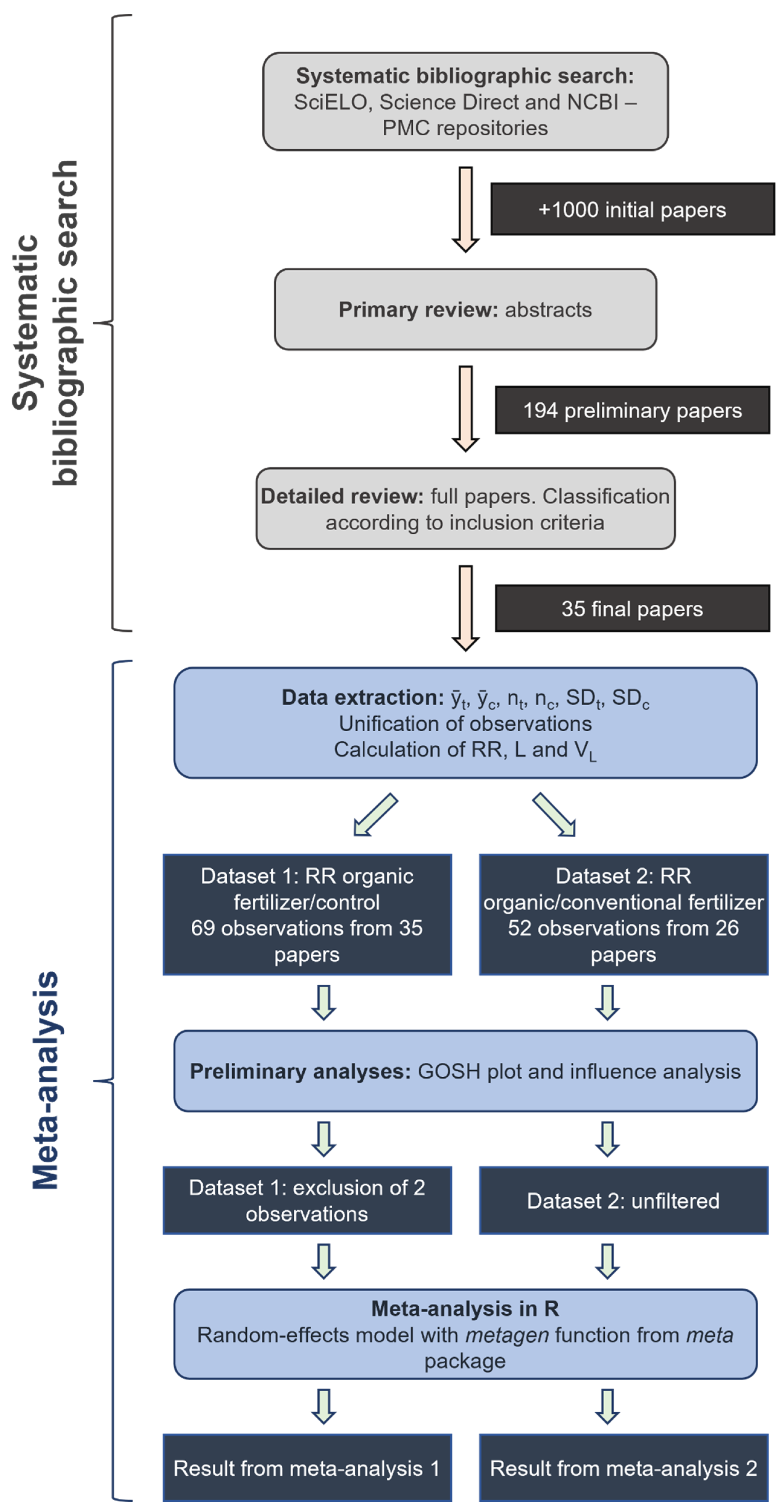

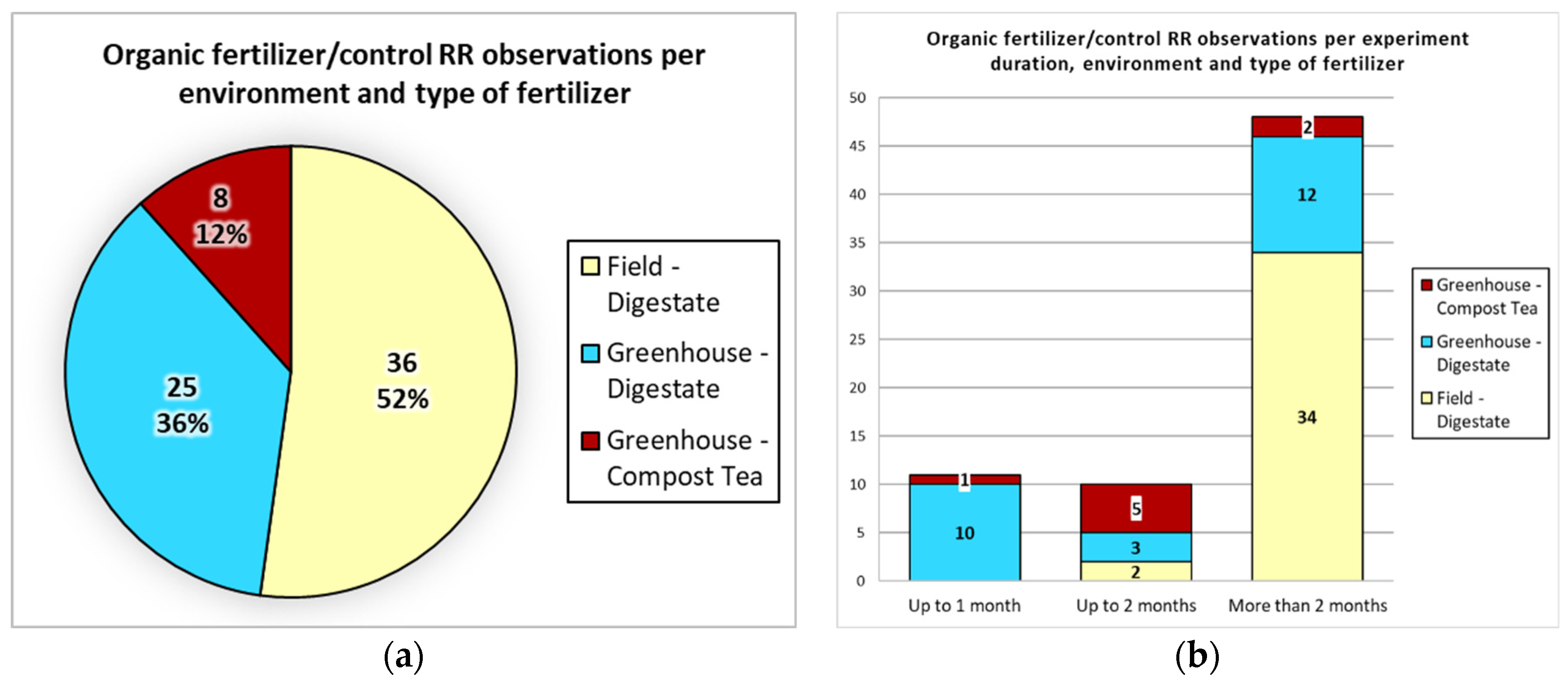
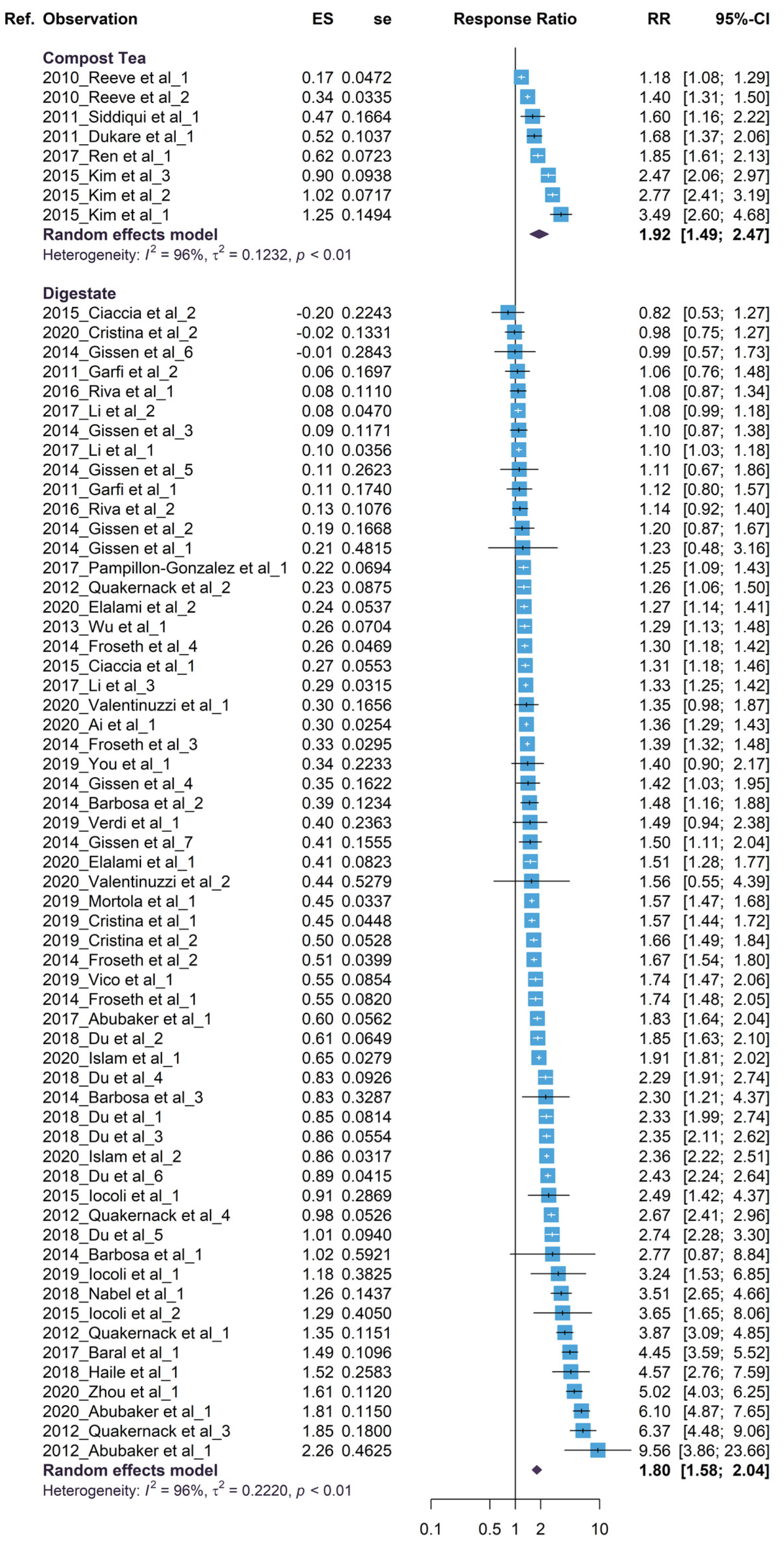
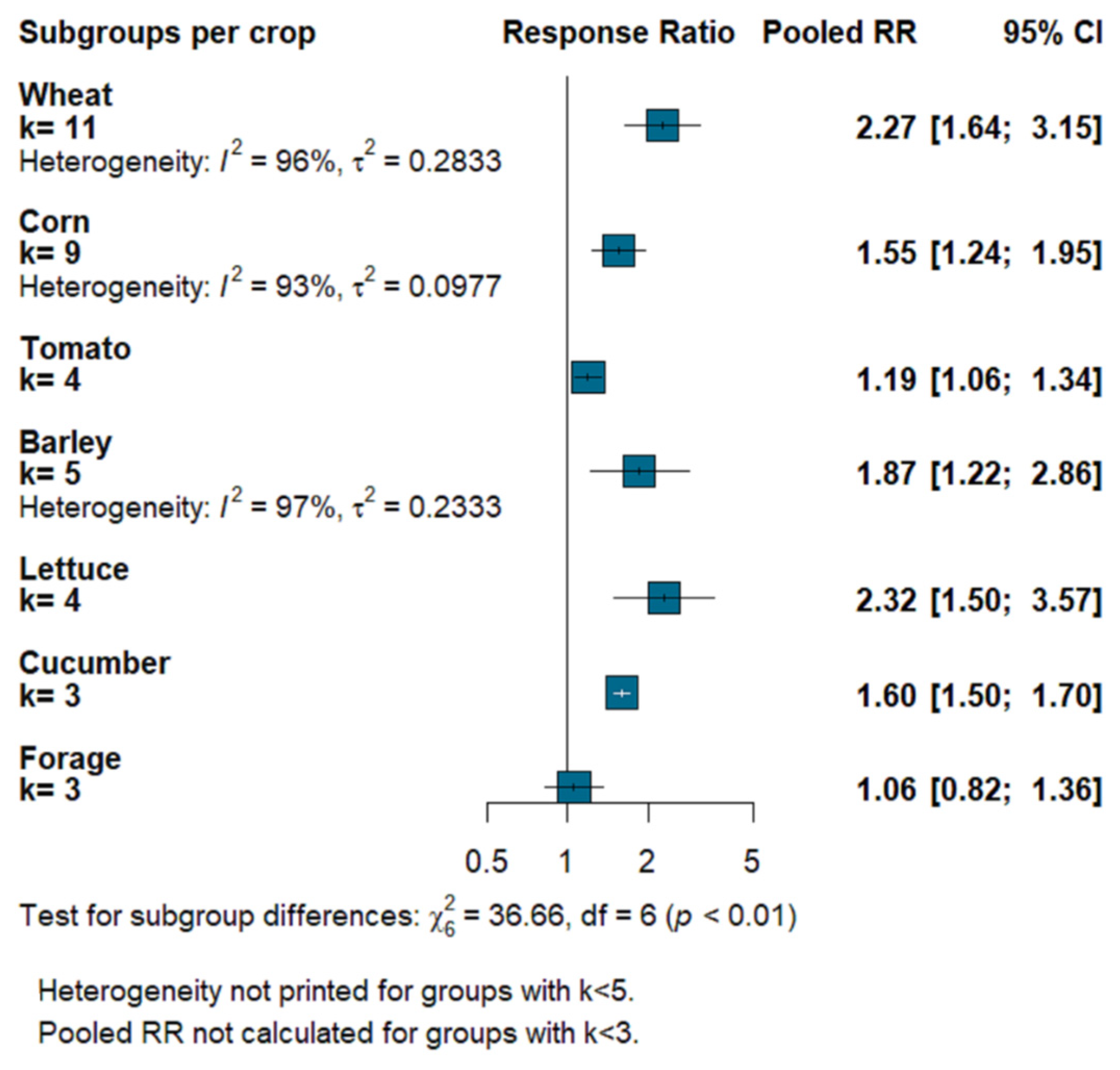

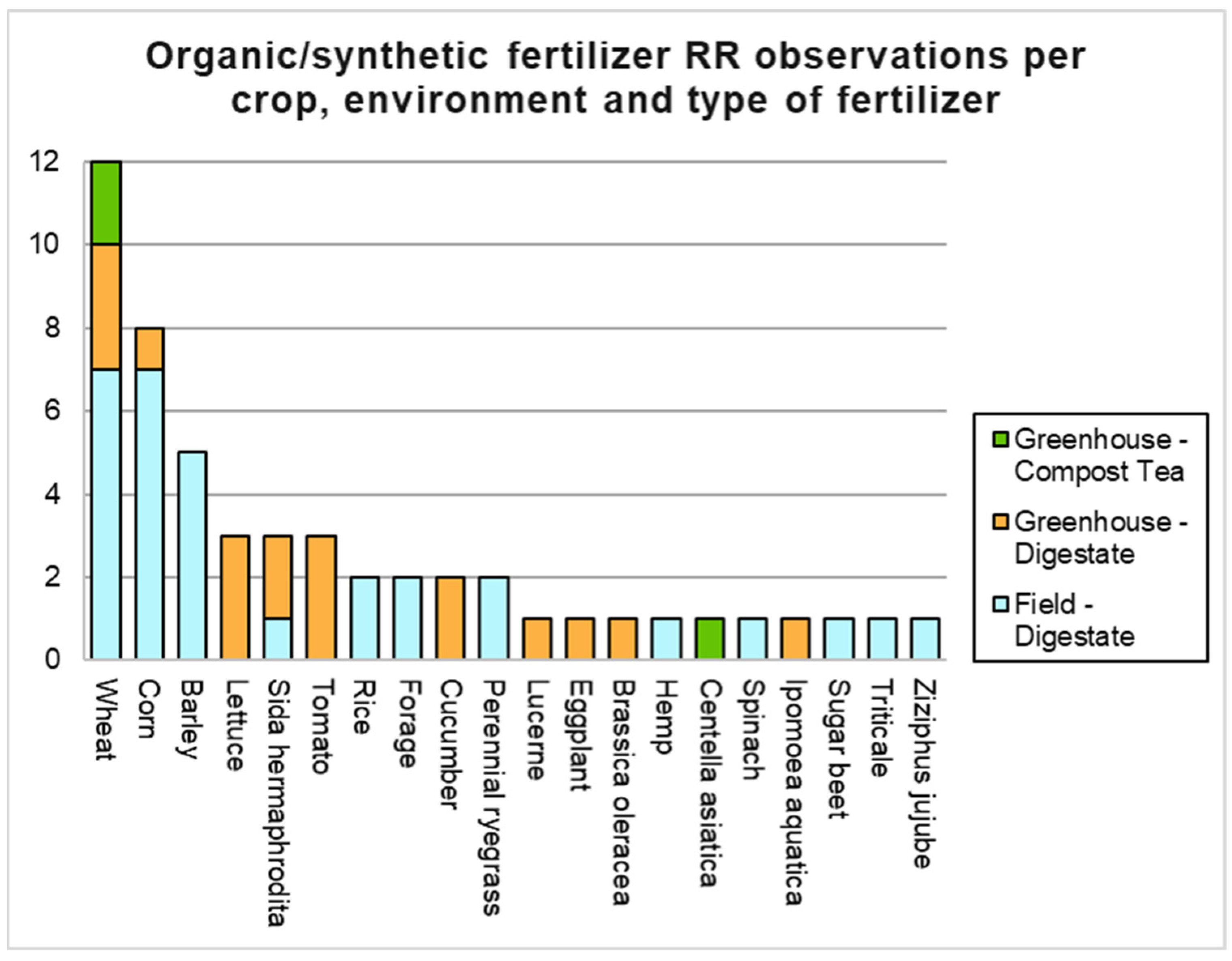
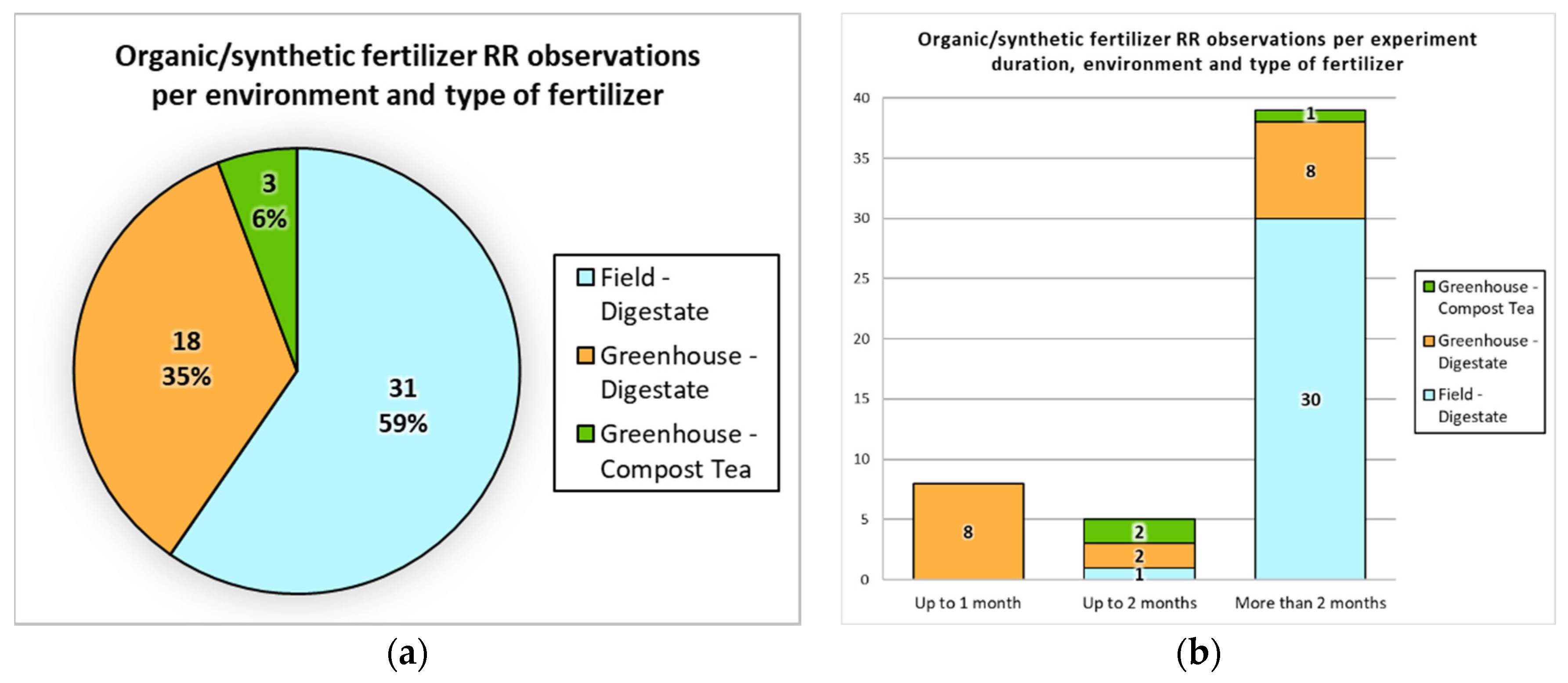
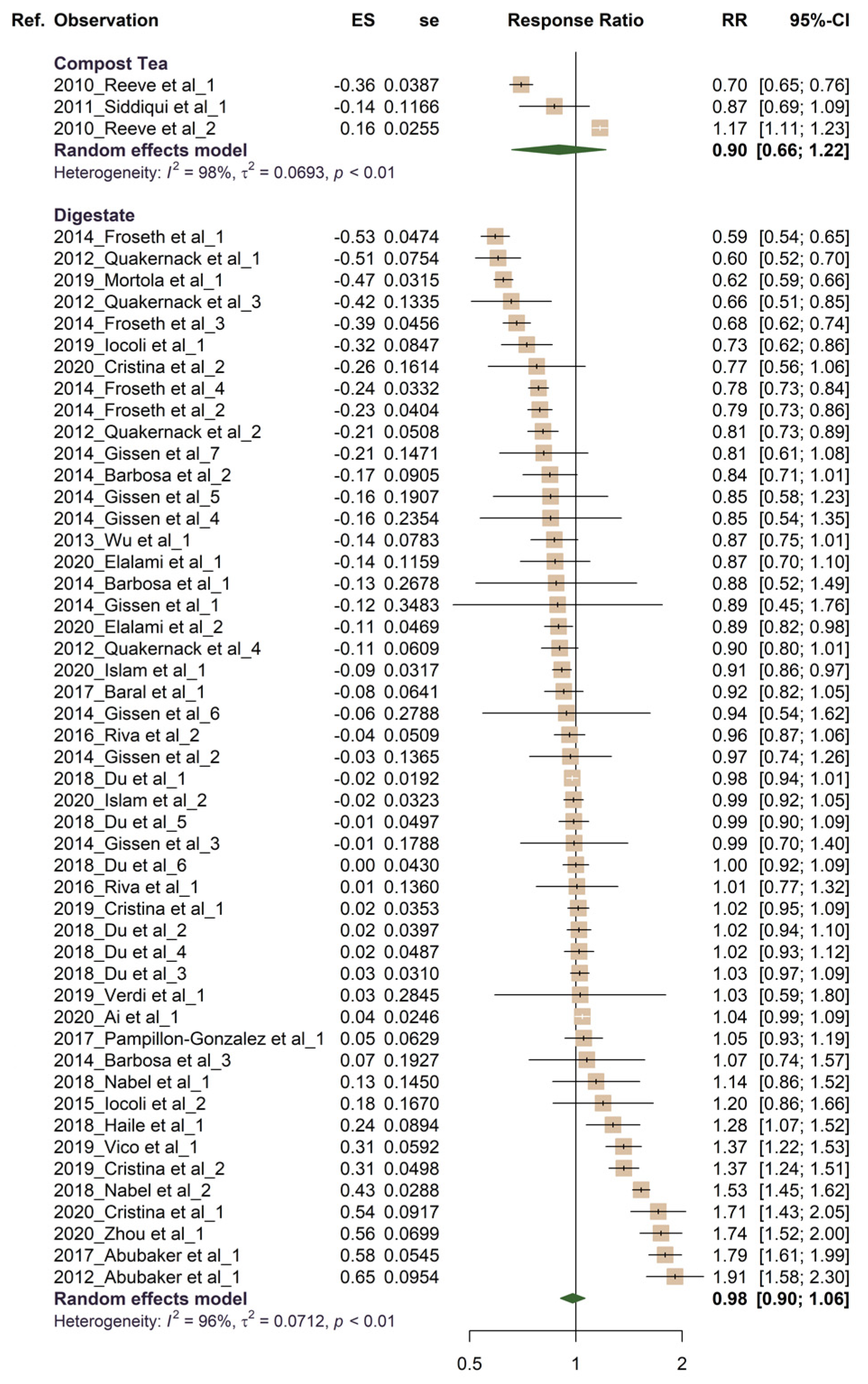



| Response Ratio | p-Value | Result | Interpretation |
|---|---|---|---|
| Digestate/control | 0.161 | Non-significant | The test does not indicate the existence of substantial asymmetry. |
| Compost tea/control | 0.079 | Non-significant | Insufficient data. |
| Digestate/synthetic fertilizer | 0.922 | Non-significant | The test does not indicate the existence of substantial asymmetry. |
| Compost tea/synthetic fertilizer | 0.697 | Non-significant | Insufficient data. |
Disclaimer/Publisher’s Note: The statements, opinions and data contained in all publications are solely those of the individual author(s) and contributor(s) and not of MDPI and/or the editor(s). MDPI and/or the editor(s) disclaim responsibility for any injury to people or property resulting from any ideas, methods, instructions or products referred to in the content. |
© 2023 by the authors. Licensee MDPI, Basel, Switzerland. This article is an open access article distributed under the terms and conditions of the Creative Commons Attribution (CC BY) license (https://creativecommons.org/licenses/by/4.0/).
Share and Cite
Curadelli, F.; Alberto, M.; Uliarte, E.M.; Combina, M.; Funes-Pinter, I. Meta-Analysis of Yields of Crops Fertilized with Compost Tea and Anaerobic Digestate. Sustainability 2023, 15, 1357. https://doi.org/10.3390/su15021357
Curadelli F, Alberto M, Uliarte EM, Combina M, Funes-Pinter I. Meta-Analysis of Yields of Crops Fertilized with Compost Tea and Anaerobic Digestate. Sustainability. 2023; 15(2):1357. https://doi.org/10.3390/su15021357
Chicago/Turabian StyleCuradelli, Franco, Marcelo Alberto, Ernesto Martín Uliarte, Mariana Combina, and Iván Funes-Pinter. 2023. "Meta-Analysis of Yields of Crops Fertilized with Compost Tea and Anaerobic Digestate" Sustainability 15, no. 2: 1357. https://doi.org/10.3390/su15021357
APA StyleCuradelli, F., Alberto, M., Uliarte, E. M., Combina, M., & Funes-Pinter, I. (2023). Meta-Analysis of Yields of Crops Fertilized with Compost Tea and Anaerobic Digestate. Sustainability, 15(2), 1357. https://doi.org/10.3390/su15021357







